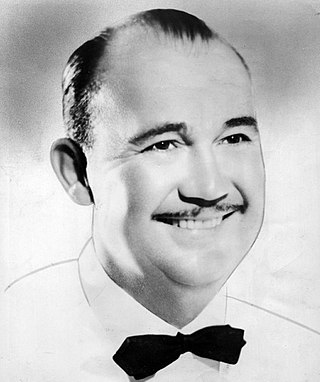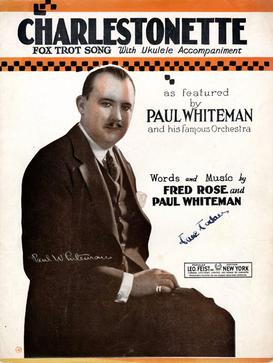Related Research Articles

In music, an arrangement is a musical adaptation of an existing composition. Differences from the original composition may include reharmonization, melodic paraphrasing, orchestration, or formal development. Arranging differs from orchestration in that the latter process is limited to the assignment of notes to instruments for performance by an orchestra, concert band, or other musical ensemble. Arranging "involves adding compositional techniques, such as new thematic material for introductions, transitions, or modulations, and endings. Arranging is the art of giving an existing melody musical variety". In jazz, a memorized (unwritten) arrangement of a new or pre-existing composition is known as a head arrangement.
A slide whistle is a wind instrument consisting of a fipple like a recorder's and a tube with a piston in it. Thus it has an air reed like some woodwinds, but varies the pitch with a slide. The construction is rather like a bicycle pump. Because the air column is cylindrical and open at one end and closed at the other, it overblows the third harmonic. "A whistle made out of a long tube with a slide at one end. An ascending and descending glissando is produced by moving the slide back and forth while blowing into the mouthpiece." "Tubular whistle with a plunger unit in its column, approximately 12 inches long. The pitch is changed by moving the slide plunger in and out, producing ascending and descending glisses."

Paul Samuel Whiteman was an American bandleader, composer, orchestral director, and violinist.

Theodore Leopold Friedman, known as Ted Lewis, was an American entertainer, bandleader, singer, and musician. He fronted a band and touring stage show that presented a combination of jazz, comedy, and nostalgia that was a hit with the American public before and after World War II. He was known by the moniker "Mr. Entertainment" or Ted "Is Everybody Happy?" Lewis. He died of lung failure in August 1971.

Rhapsody in Blue is a 1924 musical composition for solo piano and jazz band, which combines elements of classical music with jazz-influenced effects. Commissioned by bandleader Paul Whiteman and written by George Gershwin, the work premiered in a concert titled "An Experiment in Modern Music" on February 12, 1924, in Aeolian Hall, New York City. Whiteman's band performed the rhapsody with Gershwin playing the piano. Whiteman's arranger Ferde Grofé orchestrated the rhapsody several times including the 1924 original scoring, the 1926 pit orchestra scoring, and the 1942 symphonic scoring.

Ferdinand Rudolph von Grofé, known as Ferde Grofé was an American composer, arranger, pianist, and instrumentalist. He is best known for his 1931 five-movement symphonic poem, Grand Canyon Suite, and for orchestrating George Gershwin's Rhapsody in Blue for its 1924 premiere.
This is a list of notable events in music that took place in the year 1923.

Eddie Lang was an American musician who is credited as the father of jazz guitar. During the 1920s, he gave the guitar a prominence it previously lacked as a solo instrument, as part of a band or orchestra, and as accompaniment for vocalists. He recorded duets with guitarists Lonnie Johnson and Carl Kress and jazz violinist Joe Venuti, and played rhythm guitar in the Paul Whiteman Orchestra and was the favoured accompanist of Bing Crosby.

Andrew Dewey Kirk was an American jazz bandleader and saxophonist who led the Twelve Clouds of Joy, a band popular during the swing era.

Orie Frank Trumbauer was an American jazz saxophonist of the 1920s and 1930s. His main instrument was the C melody saxophone, a now-uncommon instrument between an alto and tenor saxophone in size and pitch. He also played alto saxophone, bassoon, clarinet and several other instruments.

King of Jazz is a 1930 American pre-Code color musical film starring Paul Whiteman and his orchestra. The film title refers to Whiteman's popular cultural appellation. At the time the film was made, "jazz", to the general public, meant jazz-influenced syncopated dance music heard on phonograph records, on radio broadcasts, and in dance halls. In the 1920s Whiteman signed and featured white jazz musicians including Joe Venuti and Eddie Lang, Bix Beiderbecke, Frank Trumbauer, and others.

Lester Willis Young, nicknamed "Pres" or "Prez", was an American jazz tenor saxophonist and occasional clarinetist.

"Smoke Gets in Your Eyes" is a show tune written by American composer Jerome Kern and lyricist Otto Harbach for the 1933 musical comedy Roberta. The song was sung in the Broadway show by Tamara Drasin. Its first recorded performance was by Gertrude Niesen, who recorded the song with orchestral direction from Ray Sinatra, Frank Sinatra's second cousin, on October 13, 1933. Niesen's recording of the song was released by Victor, with the B-side, "Jealousy", featuring Isham Jones and his Orchestra. The line — When your heart's on fire, smoke gets in your eyes — apparently comes from a Russian proverb.

Harrison Franklin Reser was an American banjo player and bandleader. Born in Piqua, Ohio, Reser was best known as the leader of The Clicquot Club Eskimos. He was regarded by some as the best banjoist of the 1920s.

Teddy Brown was an American entertainer and musician who spent the latter part of his life performing in Britain. His main musical instrument was the xylophone.

The Kraft Music Hall was a popular old-time radio variety program, featuring top show business entertainers, which aired first on NBC radio from 1933 to 1949.
Murray McEachern was a Canadian jazz trombonist and alto saxophonist, perhaps best known for having played trombone for Benny Goodman from 1936 to 1937. McEachern is also remembered for playing both the trombone and alto saxophone for the Casa Loma Orchestra from 1937 to 1941.
Jazz guitarists are guitarists who play jazz using an approach to chords, melodies, and improvised solo lines which is called jazz guitar playing. The guitar has fulfilled the roles of accompanist and soloist in small and large ensembles and also as an unaccompanied solo instrument.
Orchestral jazz or symphonic jazz is a form of jazz that developed in New York City in the 1920s. Early innovators of the genre, such as Fletcher Henderson and Duke Ellington, include some of the most highly regarded musicians, composers, and arrangers in all of jazz history. The fusion of jazz's rhythmic and instrumental characteristics with the scale and structure of an orchestra, made orchestral jazz distinct from the musical genres that preceded its emergence. Its development contributed both to the popularization of jazz, as well as the critical legitimization of jazz as an art form.

"Charlestonette" is a 1925 jazz composition by jazz musician and bandleader Paul Whiteman and Fred Rose. The song was released as a 78 single by Paul Whiteman and His Orchestra.
References
- ↑ "Wilbur Hall". Discogs. Retrieved 2022-07-23.
- ↑ Archived at Ghostarchive and the Wayback Machine : Little Tich. YouTube .
- ↑ "TELEVISION: Sunday, December 11, to Saturday, December 17" (PDF). Radio Times . December 9, 1938. Retrieved February 22, 2016.
- ↑ "Fred Collins' Agency". The Era. December 15, 1938. Retrieved February 22, 2016.